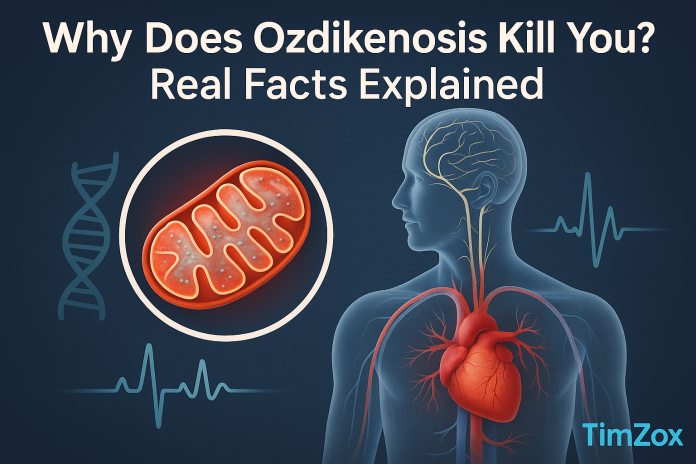Over the past few years, the internet has seen sporadic mentions of a mysterious illness known as Ozdikenosis—described as a rare, aggressive, and ultimately fatal disease. Some sources claim it causes rapid organ failure, while others suggest it results from a genetic mutation affecting energy production within cells. But is Ozdikenosis even real, or is it a fabricated condition that mimics true mitochondrial disorders?
In this article, we’ll unpack what’s known (and unknown) about Ozdikenosis, compare it to real fatal diseases, and explore why it might be mistaken for something far more scientifically established.
Is Ozdikenosis a Real Disease?
To date, there is no mention of “Ozdikenosis” in credible medical databases such as:
-
The World Health Organization’s ICD-10
-
PubMed
-
Orphanet
-
U.S. National Institutes of Health (NIH)
-
Genetic and Rare Diseases Information Center (GARD)
This strongly suggests that Ozdikenosis is not a real, clinically recognized disease.
However, the way it’s described—affecting mitochondrial function, leading to energy collapse and organ failure—closely resembles a group of real and fatal diseases: mitochondrial disorders.
What the Fictional Accounts Say About Ozdikenosis
Online posts and speculative articles claim the following about this supposed illness:
-
It’s hereditary, passed down through gene mutations
-
It attacks mitochondria, the energy producers of cells
-
Symptoms begin subtly but rapidly worsen
-
It leads to multiple organ failure within months or a few years
-
There is no known cure, and supportive treatment only delays progression
While there’s no scientific evidence to support the term “Ozdikenosis,” these features mirror real diseases that do kill.
Real Conditions That Resemble Ozdikenosis
Let’s examine real-world medical conditions that exhibit the characteristics falsely attributed to Ozdikenosis:
1. Leigh Syndrome
-
A progressive mitochondrial disorder
-
Usually presents in infancy or early childhood
-
Symptoms include poor motor control, seizures, lactic acidosis, and respiratory failure
-
Often fatal within 2–3 years of symptom onset
2. MELAS Syndrome
(Mitochondrial Encephalopathy, Lactic Acidosis, and Stroke-like Episodes)
-
A multisystem disorder caused by mutations in mitochondrial DNA
-
Causes muscle weakness, migraines, seizures, and stroke-like episodes
-
Patients often die prematurely due to neurological or cardiac complications
3. Alpers-Huttenlocher Syndrome
-
A POLG gene-related disorder
-
Manifests as intractable seizures, liver failure, and neurodegeneration
-
Leads to death in early childhood
These real diseases match every claimed symptom of Ozdikenosis, yet are backed by rigorous research.
How Mitochondrial Failure Leads to Death
If we accept that Ozdikenosis is a stand-in for mitochondrial failure, here’s why such conditions are fatal:
🔬 Cellular Energy Collapse
-
Mitochondria generate adenosine triphosphate (ATP), which powers every cell.
-
Without ATP, cells shut down, especially in high-demand tissues like the brain and heart.
🧪 Lactic Acidosis
-
Cells revert to anaerobic metabolism, producing lactic acid.
-
This leads to systemic acidosis, disrupting body chemistry and damaging organs.
🫀 Multi-Organ Failure
-
Mitochondrial disease often affects multiple organs at once.
-
Common causes of death include cardiac arrest, liver failure, and respiratory collapse.
Common Symptoms of Mitochondrial Disorders (Fictionally Called Ozdikenosis)
| System Affected | Symptoms |
|---|---|
| Nervous System | Seizures, cognitive decline, muscle rigidity |
| Muscular System | Weakness, fatigue, poor coordination |
| Cardiac System | Irregular heartbeat, heart failure |
| Digestive System | Vomiting, poor appetite, liver dysfunction |
| Metabolic System | Lactic acidosis, hypoglycemia |
These symptoms line up perfectly with online descriptions of Ozdikenosis—suggesting the term may simply be a fictional label for a very real group of diseases.
Diagnosis and Treatment (Fiction vs Fact)
Fictional Reports of Ozdikenosis Say:
-
Diagnosis requires advanced genetic and metabolic testing
-
There’s no cure; treatment is supportive
-
Patients often die within 1–2 years
Real Medical Facts:
-
Diagnosis involves:
-
Genetic sequencing
-
MRI scans
-
Muscle biopsy
-
Metabolic panels (lactate, pyruvate levels)
-
-
Treatment includes:
-
Antioxidants (Coenzyme Q10, alpha-lipoic acid)
-
Nutritional support
-
Seizure control
-
Liver and cardiac monitoring
-
Unfortunately, real mitochondrial diseases have no definitive cure either. Management is supportive and palliative in most severe cases.
Why the Name “Ozdikenosis” Persists Online
There are a few possible reasons:
-
Medical Misinformation: Someone may have created the term to simulate a serious condition.
-
AI-Generated Content: As AI becomes widespread, more fake diseases and misinformation are likely to surface.
-
Myth Inspired by Reality: Like fictional “VHL Syndrome” in early TV shows, Ozdikenosis may have been inspired by real mitochondrial disorders but with an invented name.
Genetic Counseling: A Real Lifesaver
Whether you’re concerned about Ozdikenosis or a real mitochondrial disease, genetic counseling plays a vital role:
-
Families with a history of metabolic disorders can undergo carrier screening
-
Prenatal and preimplantation testing can reduce transmission risk
-
Early detection means better treatment planning and improved quality of life
Final Verdict
Is Ozdikenosis real?
❌ No. It is not recognized by any global medical authority.
Can mitochondrial disease kill you?
✔️ Absolutely. Many mitochondrial disorders are devastatingly lethal, especially in children.
Should you worry about Ozdikenosis?
Only as a reminder of the importance of genetic health awareness, accurate information, and scientific literacy.
Read Also: Innovation News DualMedia: Future of Digital Journalism
Conclusion
“Ozdikenosis” may not be a real diagnosis, but the suffering it describes is real in many families dealing with mitochondrial disease. The internet may blur the lines between fact and fiction, but your health decisions should always be based on verifiable, scientific sources.
If you’ve encountered symptoms linked to mitochondrial dysfunction, seek care from a clinical geneticist or neurologist. Truth matters—especially when lives are at stake.


